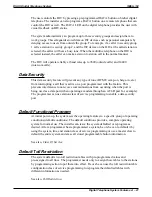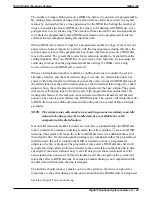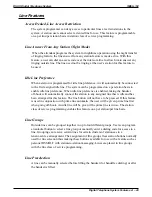
The number of rings which occurs on a DISD line before it is answered is programmable.
By setting a large number of rings, time is allowed for a call to be serviced in a regular
manner by stations that have a line appearance for the DISD line. Setting the number of
rings to 0 disables the line for DISD use. If a line is to be dedicated for DISD use, it is a
good practice to set it for one ring. The amount of time allowed for an extension number
to be dialed is programmable and a DISD assist station can be programmed to answer
calls that are not completed during this dial time limit.
When a DISD line is called, it rings for a programmed number of rings. If the call is not
answered in a normal manner by a station with the line appearance during this time, the
system answers it and, if the programmer has chosen this feature, presents a DISD dial
tone to the caller. The system then waits for an extension number to be dialed from the
calling telephone. Only one DISD line is serviced at a time; therefore, an incoming call
could ring for more than the programmed number of rings if a DISD call is being
serviced when a second DISD call is received.
When a valid extension number is dialed, a confirmation tone is sounded, the system
attempts a transfer, and the called station rings if it is idle. If a called station does not
answer within the transfer recall timeout period, the call is returned to DISD dial tone. If
the called station has the call forward feature set, the forwarded station rings. If a called
station is busy, the call is placed on hold and camped-on at the busy station. The system
will send a call waiting tone to the busy party if the programmer has enabled the call
waiting tone feature. If the camp-on is not answered within the transfer recall timeout
period, a busy tone is given followed by DISD dial tone. The system will return the caller
to DISD dial tone two additional times and then drop the line (a total of three attempts
are made).
NOTE: The system routes calls made to busy and ring-no-answer stations to an idle
station in the hunt group. If no idle stations are available, the call is
camped-on at the dialed station.
If an invalid extension number is dialed, an error tone is sounded before the DISD dial
tone is returned. If a mistake in dialing is made, the caller can dial a
✳
for a new DISD
dial tone. The system will return the caller to DISD dial tone two additional times and
then drop the line. If extension number dialing is not completed within the programmed
dial time limit, the call is routed to the DISD assist station if one is programmed;
otherwise, the line is dropped. The programmer may select a DISD dial time limit of 0
seconds, allowing callers to obtain a transfer to the assist station without having to dial
any digits. If the assist station is busy (call will camp-on at the assist station) or if the
assist station does not answer before the transfer recall timeout period, the system will
return the caller to DISD dial tone. If extension number dialing is not completed within
the dial time limit this time, the line is dropped.
The installer should connect a music source to the system so the music can provide a
reassurance to the caller during a camp-on situation when the DISD feature is being used.
See also, Digital Voice Announcing
DSU II Digital Telephone System
IMI66–132
Digital Telephone System Features A – 29
Summary of Contents for DSU II
Page 31: ......
















































